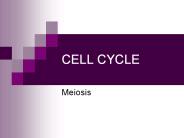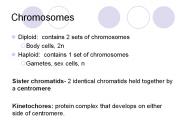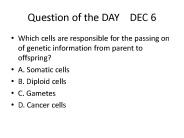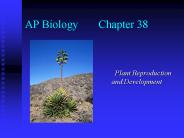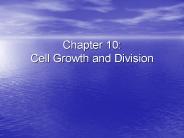Diploid PowerPoint PPT Presentations
All Time
Recommended
Down Syndrome. Trisomy 13- cleft palate, eye brain circulatory defects. Trisomy 18- death in months ... Turner Syndrome-X0- only viable monosomy in humans, ...
| PowerPoint PPT presentation | free to download
... from species to species. N constant w/in species. Humans: 2N = 46. Hermit crab: 2N = 256. Ascaris: 2N = 2. Diploidy vs. haploidy. Chromosomes ... Homologues ...
| PowerPoint PPT presentation | free to view
KEY CONCEPT During meiosis, diploid cells undergo two cell divisions that result in haploid cells. Cells go through two rounds of division in meiosis.
| PowerPoint PPT presentation | free to download
KEY CONCEPT During meiosis, diploid cells undergo two cell divisions that result in haploid cells. Cells go through two rounds of division in meiosis.
| PowerPoint PPT presentation | free to download
To produce gametes with half the number of chromosomes as other cells (somatic cells) ... One form of non-disjunction where one gamete has an extra chromosome ...
| PowerPoint PPT presentation | free to view
In which chromosome is locus a? Test: Cross all trisomics to aa and look for deviant ratios ... Conclusion: a is not on chromosome 1 ...
| PowerPoint PPT presentation | free to view
Quick review: identify this stage of the diploid cell cycle. ... Spermato- genesis. Oogenesis. Defined: Production of the egg cell (ovum) In female ovaries ...
| PowerPoint PPT presentation | free to view
Diploid Mapping 2point cross
| PowerPoint PPT presentation | free to view
Uses of Molecular Markers. Genetic characterization of plants and animals ... Molecular Markers in Strawberry. Randomly ... Complex Molecular Marker to ...
| PowerPoint PPT presentation | free to view
... B allele (genotypes: BB and BO) type AB blood both alleles ... pedigree graphical representation of a family tree. pattern of inheritance in humans ...
| PowerPoint PPT presentation | free to view
MEIOSIS: An illustration of the process by which a single ... Metaphase I: Homologous Chromosome align at ... Metaphase II: Chromosomes align at the ...
| PowerPoint PPT presentation | free to view
Gametogenesis differs between females and males. In males it is called Spermatogenesis ... Meiosis differs from mitosis in significant ways. ...
| PowerPoint PPT presentation | free to view
Title: Figure 1. T2 allotetraploids have greater nonphotochemical quenching (NPQ) capacity than their diploid progenitors under excess light. (A) NPQ response curves ...
| PowerPoint PPT presentation | free to download
... Gametes join together by fertilisation Form a diploid zygote This develops into an ... Capable of fusion to form zygote - diploid Zygote contains ...
| PowerPoint PPT presentation | free to download
... Cariocinesis Mitosis Produce n cleos gen ticamente id nticos N cleo diploide a diploide N cleo haploide a haploide Fundamento del crecimiento, ...
| PowerPoint PPT presentation | free to download
Unit 7: Cellular Reproduction 200 Ch. 22: Cell Reproduction 22:1 Mitosis & 22:2 Meiosis Diploid = 2n Diploid = 2n Formation of sex cells (gametes) Body (somatic ...
| PowerPoint PPT presentation | free to view
... more chance of mutation Fertilisation 2 haploid cells (egg, sperm) form 1 diploid cell (the zygote) ... sperm) form 1 diploid cell (the zygote) ...
| PowerPoint PPT presentation | free to view
REPRODUCTION CHAPTER 11.1 HAPLOID VS. DIPLOID CELLS Diploid cell- A cell that has two copies of each chromosome. This would include all somatic/body cells New cell ...
| PowerPoint PPT presentation | free to view
Haploid vs. Diploid. The body cells of every species have a characteristic number of chromosomes. Diploid: any cell that contains two complete sets of chromosomes
| PowerPoint PPT presentation | free to download
Do Now Take out 10.2 vocabulary homework Complete handout Remember haploid = half Diploid = double So if 20 is the diploid number, then 10 is the haploid number.
| PowerPoint PPT presentation | free to download
Diploid nucleus (2n) DNA replication. Centromere. Metaphase. 1. 2. Prophase. Chromosome ... Diploid nucleus (2n) DNA replication. Cytokinesis. Two diploid ...
| PowerPoint PPT presentation | free to view
Reduction-Division Genetic Recombination * The form of cell division by which GAMETES, with HALF the number of CHROMOSOMES, are produced. DIPLOID (2n) HAPLOID (n ...
| PowerPoint PPT presentation | free to download
Diploid = 2n ... Diploid (2n) to Haploid (n) Interphase. Interphase in meiosis is ... 2 new cells are NOT identical and are still diploid. Meiosis - Prophase II ...
| PowerPoint PPT presentation | free to view
KINGDOM PLANTAE CHAPTERS 27-31 CHARACTERISTICS Autotrophic, eukaryotic, multicellular, primarily diploid but some triploid (corn) Plant-like protists (algae) is the ...
| PowerPoint PPT presentation | free to view
... diploid number is not restored Examples Trisomy 21(Down Syndrome)- 3 copies of chromosome 21 Klinefelters Syndrome- XXY Turner Syndrome- X Supermales ...
| PowerPoint PPT presentation | free to download
... VIRUS a RNA con filamento doppio Reovirus RETROVIRUS HIV Genoma ssRNA+ diploide unico filamento (ss) pi filamenti (genoma segmentato) ...
| PowerPoint PPT presentation | free to download
B. oleracea (cabbage, cauliflower, Brocolli, kale, etc.) 2n = 18 ... The creation of triploids can be accomplished by crossing a tetraploid with a diploid, ...
| PowerPoint PPT presentation | free to download
MEIOSIS Review: Homologous Chromosomes: matching pair of chromosomes, one inherited from each parent Review Somatic : body cells, non sex cells, they are diploid ...
| PowerPoint PPT presentation | free to view
Meiosis Meiosis formation of gametes sperm and egg (haploid) fertilization uniting to form a diploid zygote reduction and division Fertilization Haploid vs ...
| PowerPoint PPT presentation | free to download
( 2n in diploid organisms) ... (diploid ) sperm (mature, haploid male gametes) Egg Formation. Growth. Meiosis I, ... (diploid) oogonium (diploid) secondary ...
| PowerPoint PPT presentation | free to view
diploid organism. inherits 2 sets of chromosomes, 1 from each parent. homologous chromosomes ... being diploid? MCC BP. Based on work by K. Foglia. www.kimunity.com ...
| PowerPoint PPT presentation | free to view
Chromosomes Diploid: contains 2 sets of chromosomes Body cells, 2n Haploid: contains 1 set of chromosomes Gametes, sex cells, n Sister chromatids- 2 identical ...
| PowerPoint PPT presentation | free to download
Today: Sexual Dimorphism Different reproductive strategies lead to differences in sexual dimorphism. haploid diploid X 23 in humans X 23 in humans X 23 in humans ...
| PowerPoint PPT presentation | free to download
Quantitative genetics and ... Diploid progeny This is a tree No it s a plant Cost Interactions Technique Gene diversity Environments Genetic parameters ...
| PowerPoint PPT presentation | free to download
Meiosis Jeopardy! With your favorite host . Mrs. Einstein Which of the following cells would be diploid? Sperm cell Egg cell Both Neither Homologous chromosomes ...
| PowerPoint PPT presentation | free to view
Structure, Growth and Division of Plant Cells ... The Process of Meiosis Haploid gametes are produced in diploid organisms Two consecutive divisions occur, ...
| PowerPoint PPT presentation | free to download
Meiosis Notes Cell division to form the gametes, sperm (male gamete) and egg (female gamete). Normal cells are diploid: 2 copies of every gene. Gametes are haploid: 1 ...
| PowerPoint PPT presentation | free to view
A. Terms you should know: 1. Homologous Chromosomes= 2. Locus = 3. Autosomes = 4. Sex chromosomes = 5. Diploid Cells = 6. Haploid Cells = 7. Fertilization =
| PowerPoint PPT presentation | free to download
Meiosis I Bivalent. 2 paired homologues (4 chromatids) 5 cross-overs. Synaptonemal Complex ... Diploid Mitosis. Mitoses. Meiosis. Syngamy. Practice. Practice ...
| PowerPoint PPT presentation | free to view
Ribosome biogenesis was most affected. Haploid cells are smaller than diploid cells ... Ploidy has an effect on ribosome biogenesis ...
| PowerPoint PPT presentation | free to download
Meiosis Notes Meiosis Meiosis occurs in sexual reproduction when a diploid germ cell produces four haploid daughter cells that can mature to become gametes (sperm or ...
| PowerPoint PPT presentation | free to view
Question of the DAY DEC 6 Which cells are responsible for the passing on of genetic information from parent to offspring? A. Somatic cells B. Diploid cells
| PowerPoint PPT presentation | free to download
AP Biology Chapter 38 Plant Reproduction and Development Sexual Reproduction Alternation of generations: haploid (n) and diploid (2n) generations take turns producing ...
| PowerPoint PPT presentation | free to download
MEIOSIS Creating gametes (sex cells) Mitosis vs Meiosis Purpose : growth and repair Occurs in somatic cells Results in two identical cells Both cells are diploid 2N ...
| PowerPoint PPT presentation | free to download
If the sperm and egg were diploid, they would create a polyploid zygote that could not survive. Does interphase occur before meiosis? Yes, ...
| PowerPoint PPT presentation | free to view
Definition: Definition: sequence: sequence: Haploid Diploid Chromosome Somatic Cells Gametes DNA Interphase Centrioles Sexual reproduction Asexual reproduction ...
| PowerPoint PPT presentation | free to view
Lovesha will open the teaching lab at 9:00AM. Read instructions in manual and on the ... Haploid versus Diploid Genetics. Haploid. genetics. Diploid. genetics ...
| PowerPoint PPT presentation | free to download
Chapter 10: Cell Growth and Division * Cells that contain both sets of homologous chromosomes are called diploid. All of your cells except the sex cells (sperm and ...
| PowerPoint PPT presentation | free to download
Meiosis Objectives 4.2.1 State that meiosis is a reduction division of a diploid nucleus to form haploid nuclei. 4.2.2 Define homologous chromosomes. 4.2.3 ...
| PowerPoint PPT presentation | free to download
AP Biology Chapter 13: Meiosis ... Mitosis Diploid multicellular organism FERTILIZATION MEIOSIS Zygote n n 2n 2n Animals Plants and some algae Most fungi and some ...
| PowerPoint PPT presentation | free to download
5 Haploid s, 4 Diploid s. Haploids are divided into 2 downtags, 3 uptag (2 ... Acknowledgements. Siew Loon Ooi. Jef Boeke. Forrest Spencer. Jean Yang ...
| PowerPoint PPT presentation | free to download
Meiosis: Making haploid reproductive cells Goal of Meiosis The purpose is to make haploid cells so that when 2 haploid cells combine you have a new diploid offspring ...
| PowerPoint PPT presentation | free to download
Meiosis begins with one diploid cell with duplicated DNA. Meiosis ends with four haploid cells with ... Haploid (n) Diploid (2n) Fertilization. Meiosis ...
| PowerPoint PPT presentation | free to view
Diploid Model. Wright-Fisher Model of ... Diploid Model with Recombination. An ... The Diploid Model Back in Time. 1- recombination histories I: ...
| PowerPoint PPT presentation | free to download
BSC 2010L Humans Haploid # of chromosomes: 23 Diploid #: 46 Remember: Have 23 pairs 1 of each pair came from mom 1 of each pair came from dad Each pair of chromosomes ...
| PowerPoint PPT presentation | free to download
Meiosis and Sexual Reproduction 10.1 Overview What are homologous chromosomes? Found in diploid cells only Identical order of genes Alleles (versions of genes) may ...
| PowerPoint PPT presentation | free to view



















